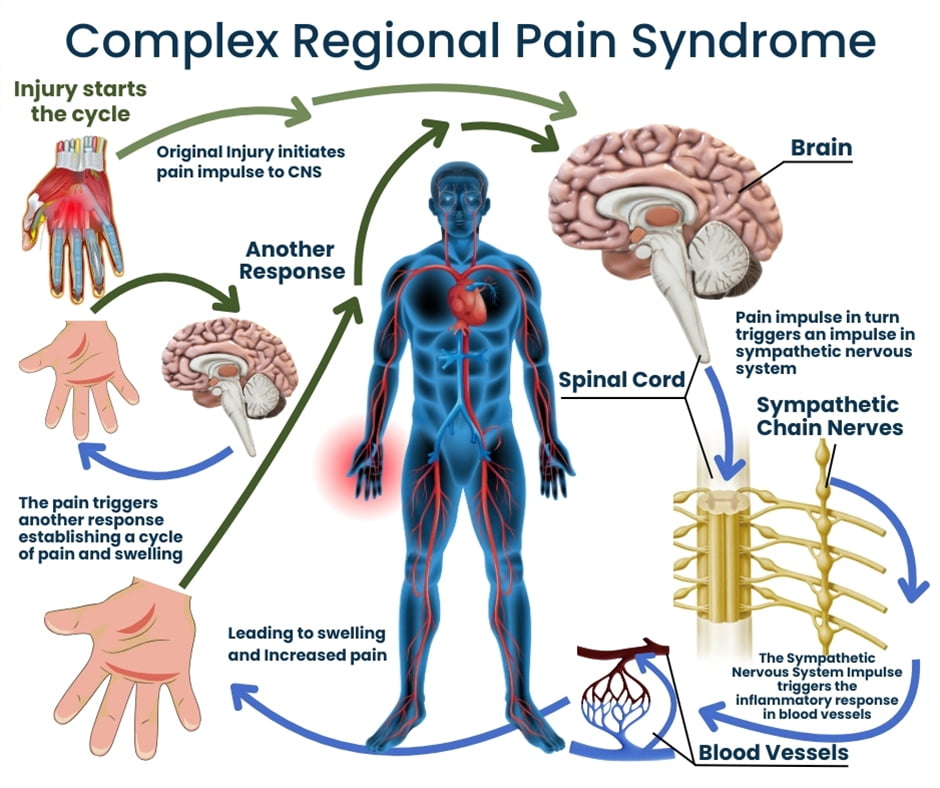Complex Regional Pain Syndrome (CRPS)

Complex Regional Pain Syndrome (CRPS)
Complex Regional Pain Syndrome (CRPS) is a chronic pain condition that most often affects an arm or a leg, usually developing after an injury, surgery, stroke, or heart attack. The pain experienced is typically severe, continuous, and disproportionate to the initial injury.
Causes
- CRPS usually follows trauma or nerve injury but the exact cause is not fully understood.
- It may involve abnormal inflammation, dysfunctional nerve signaling, and altered blood flow regulation.
- Risk factors include peripheral nerve injury, hemiplegia, and possibly tobacco smoking, which may exacerbate sympathetic nervous system activity and vasoconstriction.
Symptoms
- Pain: Continuous burning, throbbing, stabbing, or stinging pain, often severe and disproportionate to injury.
- Sensory changes: Hyperalgesia (increased pain response) and allodynia (pain from normally non-painful stimuli like light touch or temperature changes).
- Swelling and stiffness: Joint swelling, stiffness, and decreased range of motion.
- Skin changes: Altered skin color (red, white, blue), temperature fluctuations (warm or cold), texture changes (shiny, thin, tender), and abnormal sweating.
- Hair and nail changes: Abnormal growth rates or brittleness.
- Motor symptoms: Muscle spasms, tremors, weakness, and difficulty moving the affected limb.
- Bone changes: Localized osteoporosis in the affected limb.
- Psychological impact: Chronic pain can lead to anxiety, depression, and sleep disturbances.
Symptoms often start near the injury site and may spread to other parts or limbs in some cases.
Clinical Course
- Early symptoms include pain, swelling, redness, and hypersensitivity.
- Over time, the affected limb may become cold, pale, and show muscle wasting or contractures.
- Some cases resolve spontaneously; others persist for months or years and may become irreversible if untreated.
Diagnosis
- Primarily clinical, based on history and characteristic signs and symptoms.
- Imaging and tests may be used to rule out other causes and assess bone changes.
- Early diagnosis is critical for effective treatment.
Treatment
- Early intervention offers the best chance of improvement or remission.
- Multimodal approach including physical therapy, pain management (medications, nerve blocks), psychological support, and sometimes surgical interventions.
- Stress management and relaxation techniques can help reduce flare-ups.
Epidemiology
- CRPS is uncommon.
- Females are about three times more likely to be affected than males.
- Most commonly affects adults around 40 years old.
- In adults, the arm is most frequently affected; in children, the leg.
Summary Table
| Aspect | Details |
|---|---|
| Definition | Chronic pain syndrome usually affecting limbs, with pain disproportionate to injury |
| Common Triggers | Injury, surgery, stroke, heart attack |
| Key Symptoms | Burning/throbbing pain, swelling, skin color/temp changes, hypersensitivity, motor dysfunction |
| Pathophysiology | Neuroinflammation, abnormal nerve signaling, blood flow dysregulation |
| Diagnosis | Clinical evaluation, exclusion of other causes |
| Treatment | Early physical therapy, pain control, psychological support, multimodal interventions |
| Prognosis | Variable; early treatment improves outcomes; chronic cases may have irreversible changes |
| Epidemiology | More common in females; peak onset ~40 years; arm most affected in adults |
Consult with Our Team of Experts Now!
At DrStemCellsThailand (DRSCT)‘s Anti-Aging and Regenerative Medicine Center of Thailand, we emphasize comprehensive evaluations and personalized treatment plans of Cellular Therapy and Stem Cells for managing various health conditions. If you have questions about Complex Regional Pain Syndrome (CRPS) or would like more information on our services, consult with our experts today!
Consult with Our Team of Experts Now!
References
- Mayo Clinic. Complex regional pain syndrome – Symptoms & causes. 2022.
https://doi.org/10.1016/j.mayocp.2022.05.10
Mayo Clinic - Cleveland Clinic. Complex Regional Pain Syndrome (CRPS): Causes & Symptoms.
https://my.clevelandclinic.org/health/diseases/12085-complex-regional-pain-syndrome-crps - NHS. Complex Regional Pain Syndrome – Symptoms. 2022.
https://www.nhs.uk/conditions/complex-regional-pain-syndrome/symptoms/ - Better Health Channel. Complex regional pain syndrome (CRPS).
https://www.betterhealth.vic.gov.au/health/conditionsandtreatments/complex-regional-pain-syndrome-crps - Wikipedia contributors. Complex regional pain syndrome. Wikipedia. 2025.
https://en.wikipedia.org/wiki/Complex_regional_pain_syndrome - National Institute of Neurological Disorders and Stroke (NINDS). Complex Regional Pain Syndrome Information Page.
https://www.ninds.nih.gov/health-information/disorders/complex-regional-pain-syndrome
Complex Regional Pain Syndrome is a challenging chronic pain disorder with complex neuroinflammatory and vascular components. Early recognition and multidisciplinary treatment are essential to improve outcomes and prevent long-term disability.















